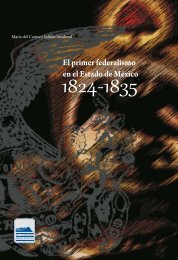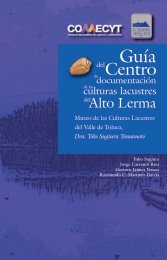You also want an ePaper? Increase the reach of your titles
YUMPU automatically turns print PDFs into web optimized ePapers that Google loves.
JOCELYN OLCOTT, SURFING THE NEW WAVE: INTERNATIONAL WOMEN’S YEAR<br />
AND THE GEOPOLITICS OF 1970S MEXICAN FEMINISM<br />
In mid-June 1975, thousands of people poured<br />
into Mexico City for the world conference<br />
honoring International Women’s Year<br />
(IWY) –the first of four UN women’s conferences<br />
and an event that turned out to be<br />
a game changer both for transnational women’s<br />
organizing and for the United Nations<br />
itself. While scholars have tended to write<br />
about IWY’s transnational impacts, the conference<br />
also shaped and was in crucial ways<br />
shaped by the so-called nueva ola of Mexican<br />
feminism. The conference itself as well<br />
as all the ancillary events provided a stage<br />
–often quite literally– for politicians and activists<br />
alike to perform their ideological convictions<br />
for audiences at home and abroad.<br />
In particular, the conference demonstrated<br />
the imbrication of feminism with geopolitics:<br />
how feminist activism shaped policy<br />
priorities and how the geopolitical context<br />
created openings and defined the possibilities<br />
for progress on feminist priorities.<br />
Mexico City: Showcase of<br />
Developmentalism<br />
Mexico City itself played an important role<br />
in giving meaning to the IWY events. By<br />
the mid-1970s, the United Nations already<br />
considered Mexico City one of the world’s<br />
three “mega-cities” along with Tokyo and<br />
New York (Ward, 2013 [1981]: 36; Davis,<br />
1994). Pollution was already considered a<br />
crisis. The metropolitan area had mushroomed<br />
over the previous three decades and<br />
sprawled into the surrounding suburbs.<br />
Squatter communities sprouted virtually<br />
overnight; the municipality of Ciudad Nezahualcóyotl<br />
had grown from a population<br />
of roughly 40,000 in 1964 to nearly 2 million<br />
by 1975. The Mexico City metropolitan<br />
area had grown from nearly 3.4 million<br />
inhabitants in 1950 to over 10.7 million by<br />
1975 (UN, 2019). This dramatic population<br />
growth mostly stemmed from rural-urban<br />
migration as modernization programs drew<br />
people from agricultural to industrial production.<br />
Like the 1968 Olympics, the 1975 International<br />
Women’s Year conference was intended<br />
to showcase Mexico City as evidence<br />
of the nation’s strides toward modernization<br />
and capacity for geopolitical leadership<br />
(Castañeda, 2014). The conference centered<br />
in two iconic locales: Tlatelolco Plaza<br />
in the north and the new Medical Center to<br />
the south. The official UN gathering of <strong>del</strong>egations<br />
representing member states took<br />
place at the Secretaría de Relaciones Exteriores<br />
on Tlatelolco Plaza, which had hosted<br />
the signing of the 1967 nuclear non-proliferation<br />
treaty but is, of course, more often remembered<br />
as the site of the notorious 1968<br />
student massacre. Five kilometers to the<br />
south, the Centro Médico (1964), the icon of<br />
Mexico’s modern welfare state, hosted the<br />
nongovernmental (NGO) gathering –what<br />
the New York Times dubbed the “scene of<br />
much shouting, scheming, plotting, and general<br />
hell- raising” (Klemesrud, 1975a: 2).<br />
The Mexico City metro system –then one<br />
of the world’s most modern– stretched directly<br />
from Tlatelolco to Hospital General,<br />
about a half mile north of Centro Médico,<br />
but travel by metro required a ten-minute<br />
walk at either end, often under soaking<br />
summer rains, and, as one participant explained,<br />
required one to “drop all dignity and<br />
wrestle the crowds for a place”. 2 Delegates<br />
and activists participating in both the government<br />
and NGO forums instead spent<br />
ages stalled in traffic on the north-south<br />
axis of Insurgentes. As Australian feminist<br />
Germaine Greer quipped:<br />
The <strong>del</strong>egates spent one third of their waking<br />
hours imprisoned in their official cars, glumly<br />
wondering if their mental stupor was another<br />
effect of the altitude or how long they could<br />
hold out in the endless traffic jams before setting<br />
off on foot in search of a toilet. The virulent<br />
Mexican version of tourist tummy laid<br />
low some of every <strong>del</strong>egation all of the time.<br />
The fourteen hotels which housed the <strong>del</strong>egates<br />
roared like Niagaras as they strained the<br />
plumbing to the utmost (Greer, 1986: 199).<br />
2 Lucile Schuck to Bob [Robert Brown], July 4, 1975;<br />
Arthur and Elizabeth Schlesinger Library on the History<br />
of Women, Lucile K. S. Longview Papers, Box 2,<br />
Folder 2. Line 3 of the Metro would not extend to Centro<br />
Médico until 1980.<br />
202



![bicentenario_1[V2]](https://img.yumpu.com/68677971/1/167x260/bicentenario-1v2.jpg?quality=85)
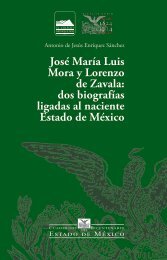
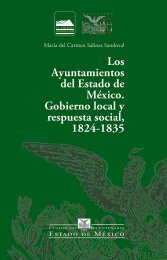

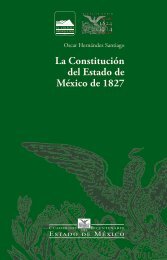
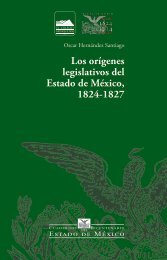
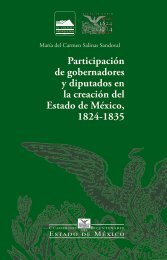
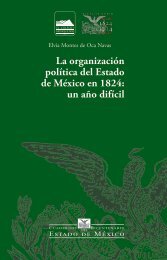
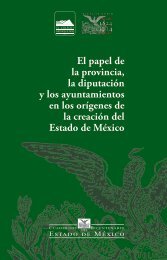

![El_primer_federalismoEM[final]_compressed (2)](https://img.yumpu.com/68483279/1/178x260/el-primer-federalismoemfinal-compressed-2.jpg?quality=85)
